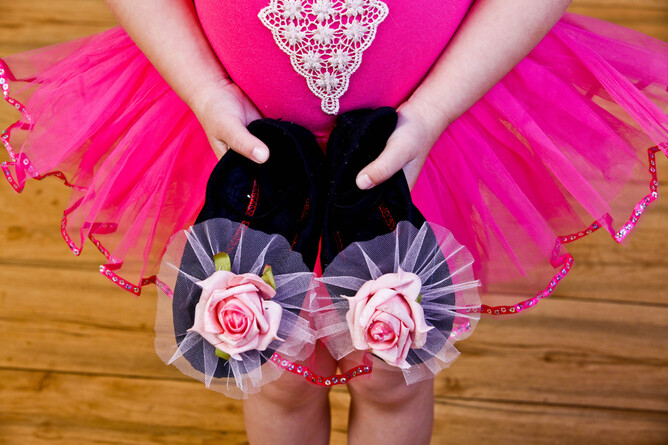Nothing is more exciting for a budding ballerina than purchasing her first pair of ballet slippers. Here are five tips to ensure you get the perfect shoes for you aspiring dancer:
Tip 1: The Perfect Fit
Tip 2: The Perfect Size
Tip 3: The Perfect Type
Tip 4: The Perfect Colour
Tip 5: The Perfect Price
Tip 1: The Perfect Fit
For ballet slippers, the single most important factor is a snug fit. The shoe should fit like a sock – not too snug as to curl the toes inside the shoe, and not too loose where you can pinch extra material at the tip of the shoe and the leather puckers.
Children's feet are developing and growing. A snug fit will allow your child to “feel” the floor with her feet when learning technique. The earlier your ballerina learns proper positions, the less injury she will sustain to the knees and ankles down the road. It is important to have a snug-fitting shoe to help support a ballet dancers’s stance, allow the teacher to catch and correct problems like pronation, and prevent injury later in life.
Children's feet are developing and growing. A snug fit will allow your child to “feel” the floor with her feet when learning technique. The earlier your ballerina learns proper positions, the less injury she will sustain to the knees and ankles down the road. It is important to have a snug-fitting shoe to help support a ballet dancers’s stance, allow the teacher to catch and correct problems like pronation, and prevent injury later in life.
Tip 2: The Perfect Size
Slipper sizes tend to run a few sizes below average street size. You might hear that you should buy a ballet slipper a half size larger that he or she will grow into. Slippers that are too big, can make it more difficult for a child to learn correct positioning, and can cause clumsiness. This could set him or her back in advancing to the next level, so be careful to choose a slipper no more than ½ a size bigger, and be sure the fit is closer to being snug than loose.
Tip 3: The Perfect Type
Anything from a single-sole leather ballet shoe to a split-sole canvas shoe. The typical “first” ballet shoe for children is a leather shoe with a single leather sole. This is best to help support the foot early on. As your little dancer progresses, split-sole shoes might be better to help point through the slippers.
Tip 4: The Perfect Colour
Ballet shoes come in a range of colors. Be sure to check what is appropriate for your chosen dance class. In some ballet schools, a uniform look helps the instructor to scan the room more easily to ensure students are performing and learning dance moves correctly.
Tip 5: The Perfect Price
In general, ballet slippers are among the least expensive dance shoes. For children, it is important that you don't substitute quality for a cheaper price. Slippers that are not properly fit or constructed can be detrimental to your young dancers learning ability. As a little dancer’s feet grow, new shoes will be needed to maintain the proper support. Properly fitting shoes can be distracting for children during class time.
For children, dance is an exciting learning experience. Having the right shoes will help them enjoy that experience so much more. Though they may not tell you when they have a great fitting shoe, they will tell you if something doesn’t feel right. If you aren’t sure what the issue might be, don’t hesitate to ask the instructor about the problem and they will be happy to help.
For children, dance is an exciting learning experience. Having the right shoes will help them enjoy that experience so much more. Though they may not tell you when they have a great fitting shoe, they will tell you if something doesn’t feel right. If you aren’t sure what the issue might be, don’t hesitate to ask the instructor about the problem and they will be happy to help.
